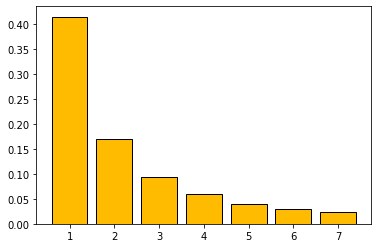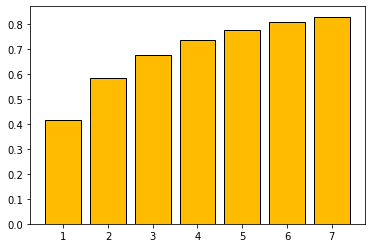In mathematics, the Gauss–Kuzmin distribution is a discrete probability distribution that arises as the limit probability distribution of the coefficients in the continued fraction expansion of a random variable uniformly distributed in (0, 1).[4] The distribution is named after Carl Friedrich Gauss, who derived it around 1800,[5] and Rodion Kuzmin, who gave a bound on the rate of convergence in 1929.[6][7] It is given by the probability mass function
|
Probability mass function  | |||
|
Cumulative distribution function  | |||
| Parameters | (none) | ||
|---|---|---|---|
| Support | |||
| PMF | |||
| CDF | |||
| Mean | |||
| Median | |||
| Mode | |||
| Variance | |||
| Skewness | (not defined) | ||
| Excess kurtosis | (not defined) | ||
| Entropy | 3.432527514776...[1][2][3] | ||
Gauss–Kuzmin theorem
editLet
be the continued fraction expansion of a random number x uniformly distributed in (0, 1). Then
Equivalently, let
then
tends to zero as n tends to infinity.
Rate of convergence
editIn 1928, Kuzmin gave the bound
In 1929, Paul Lévy[8] improved it to
Later, Eduard Wirsing showed[9] that, for λ = 0.30366... (the Gauss–Kuzmin–Wirsing constant), the limit
exists for every s in [0, 1], and the function Ψ(s) is analytic and satisfies Ψ(0) = Ψ(1) = 0. Further bounds were proved by K. I. Babenko.[10]
See also
editReferences
edit- ^ Blachman, N. (1984). "The continued fraction as an information source (Corresp.)". IEEE Transactions on Information Theory. 30 (4): 671–674. doi:10.1109/TIT.1984.1056924.
- ^ Kornerup, Peter; Matula, David W. (July 1995). "LCF: A Lexicographic Binary Representation of the Rationals". J.UCS the Journal of Universal Computer Science. Vol. 1. pp. 484–503. CiteSeerX 10.1.1.108.5117. doi:10.1007/978-3-642-80350-5_41. ISBN 978-3-642-80352-9.
{{cite book}}:|journal=ignored (help) - ^ Vepstas, L. (2008), Entropy of Continued Fractions (Gauss-Kuzmin Entropy) (PDF)
- ^ Weisstein, Eric W. "Gauss–Kuzmin Distribution". MathWorld.
- ^ Gauss, Johann Carl Friedrich. Werke Sammlung. Vol. 10/1. pp. 552–556.
- ^ Kuzmin, R. O. (1928). "On a problem of Gauss". Dokl. Akad. Nauk SSSR: 375–380.
- ^ Kuzmin, R. O. (1932). "On a problem of Gauss". Atti del Congresso Internazionale dei Matematici, Bologna. 6: 83–89.
- ^ Lévy, P. (1929). "Sur les lois de probabilité dont dépendant les quotients complets et incomplets d'une fraction continue". Bulletin de la Société Mathématique de France. 57: 178–194. doi:10.24033/bsmf.1150. JFM 55.0916.02.
- ^ Wirsing, E. (1974). "On the theorem of Gauss–Kusmin–Lévy and a Frobenius-type theorem for function spaces". Acta Arithmetica. 24 (5): 507–528. doi:10.4064/aa-24-5-507-528.
- ^ Babenko, K. I. (1978). "On a problem of Gauss". Soviet Math. Dokl. 19: 136–140.

![{\displaystyle -\log _{2}\left[1-{\frac {1}{(k+1)^{2}}}\right]}](https://wikimedia.org/api/rest_v1/media/math/render/svg/d8a5d1a2a434c302f66ad98221f4ed545d8f2984)




